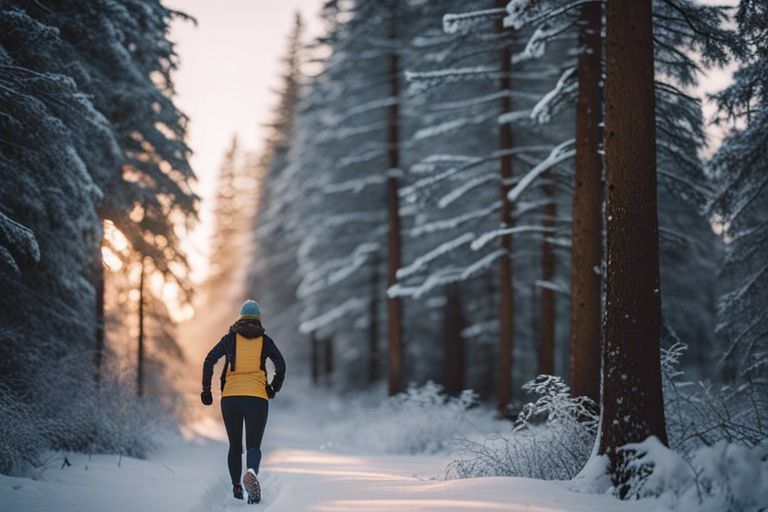When the winter weather arrives, many joggers may feel discouraged to hit the snowy terrain. However, with the right gear, running on snow-covered paths can be not only possible but enjoyable. From shoes with reliable traction to thermal running tights, there is a range of gear specifically designed to keep you warm, safe, and comfortable while jogging in snowy conditions. In this blog post, we will explore the best jogging gear to help you stay active during the winter months and make your snowy runs a success.
Key Takeaways:
- Invest in trail running shoes: Choose a pair with extra grip and waterproofing to navigate snowy terrain safely.
- Layer up with moisture-wicking clothing: Stay warm and dry by wearing moisture-wicking base layers under insulating tops.
- Wear reflective gear: Ensure visibility in low-light conditions with reflective jackets, vests, or accessories.
- Protect your extremities: Keep hands warm with insulated gloves and feet dry with waterproof socks or gaiters.
- Carry vitals in a running belt: Pack necessities like water, snacks, a mobile phone, and first aid kit in a lightweight and adjustable running belt.
Footwear
Insulated Running Shoes
When jogging in snowy terrain, it’s important to keep your feet warm and dry. Invest in a pair of insulated running shoes that provide extra protection against the cold. Look for shoes with thermal lining and waterproof materials to ensure your feet stay comfortable throughout your run.
Traction Aids for Shoes
To prevent slipping and sliding on icy paths, consider getting traction aids for your running shoes. These accessories can easily be attached to the sole of your shoes and provide extra grip on slippery surfaces. Choose traction aids with durable spikes or metal studs for the best traction in snowy conditions.
Winter running can be challenging, especially when it comes to maintaining your balance on slippery surfaces. Traction aids for shoes are designed to help you stay stable and secure while jogging in snowy terrain. They are lightweight, compact, and easy to use, making them a must-have accessory for winter runners looking to stay safe and confident during their workouts.
Clothing
Layering for Insulation and Moisture Wicking
When jogging in snowy terrain, it is necessary to layer your clothing for both insulation and moisture-wicking properties. Start with a moisture-wicking base layer to draw sweat away from your skin, followed by an insulating layer to trap heat. Finish with a waterproof and windproof outer layer to protect you from the elements.
Water-Resistant and Windproof Outerwear
Investing in water-resistant and windproof outerwear is crucial for running in snowy conditions. Look for jackets and trousers made from materials like Gore-Tex or similar technologies that offer both water resistance and breathability. These garments will shield you from snow and wind while allowing excess heat and moisture to escape, keeping you dry and comfortable throughout your jog.
Additionally, consider accessories like waterproof hats and gloves to complete your winter jogging ensemble. These items will help protect your extremities from the cold and ensure a more enjoyable and safe outdoor workout experience.
Accessories
Protective Headgear and Gloves
When jogging in snowy terrain, it is important to protect your head and hands from the cold and potential injuries. Invest in a good quality beanie hat or headband to keep your head warm, along with waterproof and insulated gloves to protect your hands. Make sure the gloves are touchscreen compatible so you can easily use your devices without exposing your skin to the cold.
Visibility and Safety Equipment
Visibility is crucial when jogging in snowy conditions, especially during low light hours. Equip yourself with reflective vests, armbands, and LED lights to ensure you are visible to others, such as drivers or fellow outdoor enthusiasts. Safety should always be a top priority, so consider adding a whistle to your gear in case of emergencies.
Furthermore, wearing bright and reflective clothing can significantly increase your visibility, reducing the risk of accidents. Opt for jackets, leggings, and accessories with reflective strips or patterns for maximum safety during your snowy terrain runs.
Maintenance and Care
Cleaning and Storing Snow Jogging Gear
After a challenging run in snowy terrain, it’s necessary to properly clean and store your snow jogging gear to maintain its quality and longevity. Make sure to follow the manufacturer’s instructions for washing and drying your gear. Wipe off any dirt or mud, and ensure that your shoes are thoroughly dry before storing them in a cool, dry place away from direct sunlight.
Tips for Longevity of Gear
To ensure your snow jogging gear lasts for many seasons, there are several tips you can follow. Avoid washing your gear too frequently as this can cause wear and tear. Instead, spot clean any stains and air out your gear after each use. Additionally, avoid storing your gear in plastic bags as this can cause mould growth. Opt for breathable storage bags or hang your gear in a well-ventilated area.
- Avoid washing your gear too frequently as this can cause wear and tear. The same applies to using harsh detergents.
The Best Jogging Gear for Snowy Terrain
To sum up, when running in snowy terrain, it is crucial to have the right gear to stay safe and comfortable. Opt for trail running shoes with excellent grip, thermal running tights, moisture-wicking base layers, windproof and waterproof outer layers, a warm hat and gloves, and sunglasses to protect your eyes from the glare of the snow. Additionally, consider using traction devices like spikes or grips for added stability on icy surfaces. By investing in the appropriate jogging gear for snowy conditions, you can continue to enjoy your runs while minimising the risk of injury and maximising your performance in the winter months.
FAQ
Q: What should I consider when choosing jogging gear for snowy terrain?
A: When selecting jogging gear for snowy terrain, you should consider water resistance, insulation, traction, and visibility. Look for clothing and footwear that will keep you dry, warm, and provide good grip on slippery surfaces.
Q: How important is water resistance in jogging gear for snowy terrain?
A: Water resistance is crucial in jogging gear for snowy terrain as it helps to keep you dry and comfortable. Wet clothing can lead to hypothermia in cold conditions, so opting for water-resistant materials is imperative.
Q: Why is insulation important in jogging gear for snowy terrain?
A: Insulation is vital in jogging gear for snowy terrain as it helps to keep your body warm by trapping heat. Look for clothing with thermal properties or layering options to regulate your body temperature effectively.
Q: What type of traction should I look for in jogging shoes for snowy terrain?
A: When choosing jogging shoes for snowy terrain, look for ones with aggressive lugs and good traction. Opt for footwear with a sturdy outsole that provides grip on icy and slippery surfaces to prevent slips and falls.
Q: How can I ensure visibility when jogging in snowy terrain?
A: To enhance visibility when jogging in snowy terrain, opt for clothing with reflective elements or wear bright colours. Consider using a headlamp or reflective gear to make yourself more visible to others, especially in low light conditions.






